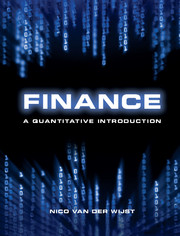Book contents
- Frontmatter
- Contents
- List of Figures
- List of Tables
- Acronyms
- Preface
- 1 Introduction
- 2 Fundamental concepts and techniques
- 3 Modern portfolio theory
- 4 Market efficiency
- Chapter 5 Capital structure and dividends
- 6 Valuing levered projects
- 7 Option pricing in discrete time
- 8 Option pricing in continuous time
- 9 Real options analysis
- 10 Selected option applications
- 11 Hedging
- 12 Agency problems and governance
- Solutions to exercises
- Glossary
- References
- Index
1 - Introduction
Published online by Cambridge University Press: 05 February 2013
- Frontmatter
- Contents
- List of Figures
- List of Tables
- Acronyms
- Preface
- 1 Introduction
- 2 Fundamental concepts and techniques
- 3 Modern portfolio theory
- 4 Market efficiency
- Chapter 5 Capital structure and dividends
- 6 Valuing levered projects
- 7 Option pricing in discrete time
- 8 Option pricing in continuous time
- 9 Real options analysis
- 10 Selected option applications
- 11 Hedging
- 12 Agency problems and governance
- Solutions to exercises
- Glossary
- References
- Index
Summary
This opening chapter introduces finance as a scientific discipline and outlines its main research tools. We also take a brief look at the book’s central theme, the calculation of value, and the main ways to account for risk in these calculations. To illustrate the differences between finance and the natural sciences we compare results of a Nobel prize-winning financial model with measurements of a NASA space probe.
Finance as a science
What is finance?
Finance studies how people choose between uncertain future values. Finance is part of economics, the social science that investigates how people allocate scarce resources, that have alternative uses, among competing goals. Both scarcity, i.e. insufficient resources to achieve all goals, and possible alternative uses are necessary ingredients of economic problems. Finance studies such problems for alternatives that involve money, risk and time. Financial problems can refer to businesses, in which case we speak of corporate finance, but also to individuals (personal finance), to governments (public finance) and other organizations. Financial choices can be made directly or through agents, such as business managers acting on behalf of stockholders or funds managers acting on behalf of investors. For the most part, we shall study choices made by businesses in financial markets, but the results have a wider validity. As we shall see, financial markets facilitate, simplify and increase the possibilities to choose. Some typical problems we will look at are:
Should company X invest in project A or not?
How should we combine stocks and risk-free borrowing or lending in our investment portfolio?
What is the best way to finance project C?
How can we price or eliminate (hedge) certain risks?
What is the value of flexibility in investment projects?
Information
- Type
- Chapter
- Information
- FinanceA Quantitative Introduction, pp. 1 - 9Publisher: Cambridge University PressPrint publication year: 2013
